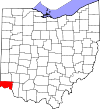
William Dunlap Simpson was the 78th governor of South Carolina from February 26, 1879, when the previous governor, Wade Hampton, resigned to take his seat in the U.S. Senate, until 1880. That year Simpson resigned to become Chief Justice of the South Carolina Supreme Court.

Haddington is a neighborhood in the West Philadelphia section of Philadelphia, Pennsylvania, United States. Its borders are defined as Haverford Avenue/Girard Avenue to the north, 52nd Street to the east, Market Street to the south, and 67th Street to the westernmost edge of the neighborhood.
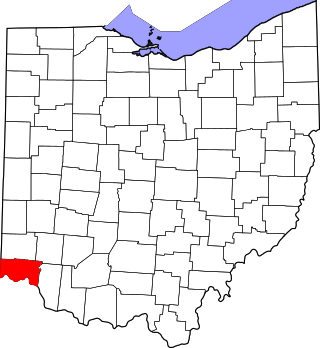
This is a list of the National Register of Historic Places listings in Hamilton County, Ohio.
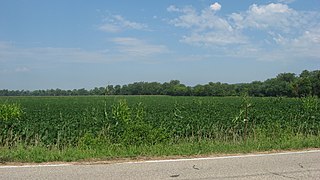
Colerain Works Archeological District is a registered historic district near Dunlap, Ohio, listed in the National Register of Historic Places on June 18, 1976. It contains 0 contributing buildings.

Dunlap's Creek Bridge is the first arch bridge in the United States built of cast iron. It was designed by Richard Delafield and built by the United States Army Corps of Engineers. Constructed from 1836 to 1839 on the National Road in Brownsville, Pennsylvania, it remains in use today. It is listed on the National Register of Historic Places and is a National Historic Civil Engineering Landmark (1978). It is located in the Brownsville Commercial Historic District and supports Market Street, the local main thoroughfare. Due to the steep sides of the Monongahela River valley, there is only room for two short streets parallel to the river's shore and graded mild enough to be comfortable to walk before the terrain rises too steeply for business traffic.
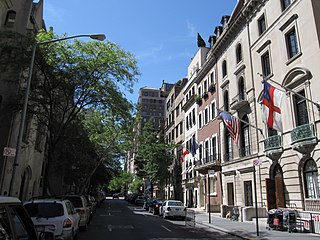
The Upper East Side Historic District is a landmarked historic district on the Upper East Side of New York City's borough of Manhattan, first designated by the city in 1981. It was listed on the National Register of Historic Places in 1984. Its boundaries were expanded in 2010.

The Catlin Wilson House, also known as the Murphy Dunlap House, is a historic Greek Revival style house in Eutaw, Alabama, United States. The one-story wood-framed building was built in 1844. A pedimented front portico with four Doric columns covers the three central bays of the front facade. The house was recorded by the Historic American Buildings Survey in 1936. It was listed on the Alabama Register of Landmarks and Heritage on November 5, 1976. It was subsequently added to the National Register of Historic Places as a part of the Antebellum Homes in Eutaw Thematic Resource on April 2, 1982, due to its architectural significance.

Laurens Historic District is a national historic district located at Laurens, Laurens County, South Carolina. It encompasses 77 contributing buildings and 1 contributing structure in Laurens. The district includes residential, commercial, religious, and governmental buildings built between 1880 and 1940. Notable buildings include the Laurens County Courthouse, Old Methodist Church, St. Paul First Baptist Church, Public Square commercial buildings, Rosenblum's and Maxwell Bros. and Kinard Store, Provident Finance Co. and Parker Furniture, McDonald House, Augustus Huff House, Gov. William Dunlap Simpson House, and Hudgens-Harney House.

The William B. Dunlap Mansion was a historic house in Bridgewater, Pennsylvania, United States. Erected in 1840 on a bluff over the Beaver River in the northern part of the borough, it has been ranked as the grandest and best-preserved 19th-century house in Bridgewater. On January 16th, 2017, the structure was demolished by borough authorities following condemnation.

William Boyd Dunlap was a former Democratic member of the Pennsylvania State Senate.

The West End Historic District in Waxahachie, Texas is a 77-acre (31 ha) historic district that was listed on the National Register of Historic Places in 1986. It is mainly seven blocks of W. Main St. and four blocks of W. Jefferson St., and includes properties on cross streets as well.

The Northville Historic District is located in Northville, Michigan. It was designated a Michigan State Historic Site in 1970 and listed on the National Register of Historic Places in 1972. The district is roughly bounded by Cady Street, Rogers Street, and Randolph Street; alterations to the boundaries of the city-designated district in 2003 and 2007 included structures on the opposite sides of the original bounding streets within the district. The district is located in the heart of old Northville, and is primarily residential, although the 73 contributing structures, include several commercial buildings and a church. The majority of the district contains Gothic Revival houses constructed between 1860 and 1880.

Thomas Dunlap School is an historic, former American school building that is located in the Haddington neighborhood of Philadelphia, Pennsylvania.
The Stuart Dunlap House on 7th Ave. in Mandan, North Dakota was listed on the National Register of Historic Places in 1992.

Elmer E. Dunlap was an architect of Indianapolis, Indiana and a contractor from Columbus, Indiana, who worked often on projects designed by prolific architect William Ittner.

The Ralph Waldo Emerson Indianapolis Public School #58 is a historic school building located on N. Linwood St. in Indianapolis, Indiana, United States. It was built in 1907 according to a design by R.P. Daggett and Co. It is a two-story, rectangular brick building on a raised basement in a simplified Classical Revival style. Additions were made to the building in 1917, 1921, and 1967.

Dunlap's Dining Room was a restaurant operated out of the residence of black entrepreneur George T. Dunlap in Sacramento, California. The business was popular in its time and building is now listed on the National Register of Historic Places.

The Dunlap Building is a historic commercial building at 967 Elm Street in downtown Manchester, New Hampshire. It is a large five-story brick building occupying a corner lot on Manchester's principal commercial street. It was built in 1879 as a four-story building, and extensively rebuilt in 1908, when the fifth story was added. The first floor is lined by storefronts on both Elm and Amherst Streets. The second through fourth floors of the Elm Street facade are three bays wide, the bays divided by pilasters. Separate pilasters separate the bays on the top floor. The original second-floor windows were replaced in 1908 by large plate-glass windows. The third-floor windows have a segmented-arch top and the original 1879 window surrounds, although the windows themselves have been replaced by modern sash windows. The windows on the upper two floors are in rectangular openings with granite sills. The Amherst Street facade is also divided by pilasters and has similar window treatments, although a number of the second-floor windows have been partially bricked over.

William Dunlap Simpson House is a historic home located at Laurens, Laurens County, South Carolina, USA. It was built about 1839 for a planter to use as his town house. The three-story, three-bay, Greek Revival style clapboard dwelling has a total of twelve rooms.
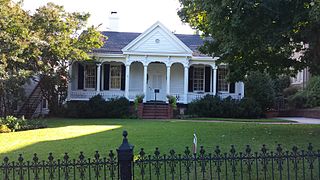
The Munroe–Dunlap–Snow House in Macon, Georgia is a small house that was built in about 1857. It appears originally to have been a five-room Victorian cottage. It is listed on the National Register of Historic Places individually as well as by serving as a contributing building in the Macon Historic District.

